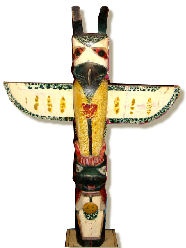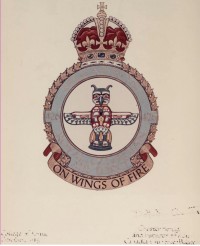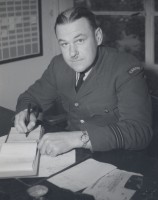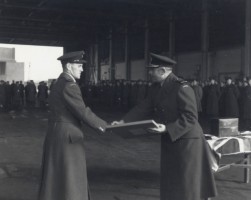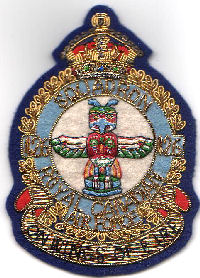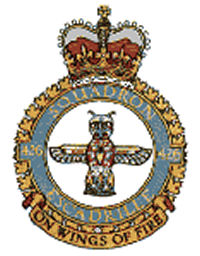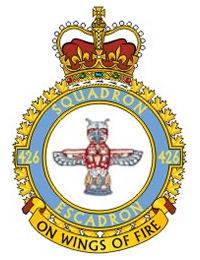The Squadron Badge
As the unit was forming in the fall of ’42, Wing Commander Blanchard suggested that they be known as the “Thunderbird Squadron” and assigned the Adjutant, Flight Lieutenant Connor to handle it. Connor contacted Tony Lascelles, a friend of his who was a field naturalist at Banff National Park. | |
| Lascelles could not provide a coloured picture of a thunderbird totem, but he did send a brochure on totem poles of British Columbia and a model totem pole about fifteen inches high that he had arranged to be carved. In a letter to Connor, Lascelles wrote: "The Thunderbird, of course, is purely mythical and has, as is usually the case with totems, no counterpart in nature. It is believed that the Thunderbird lives in the sun, but inhabits at times dense clouds close to earth where, on occasion, it makes its presence known by causing the noise of thunder with its wings. It is also believed that should the Thunderbird ever reveal itself to human eyes, great disaster will follow because some earthly happening has caused it displeasure…."
|
A very early copy of the badge, before royal assent, in the corner it is signed by Sir John D. Heaton-Armstrong, the Chester Herald. This copy now hangs in the Technical Instructors hall, Dishforth Building, Trenton. | "The Thunderbird, as applied to the warplane, is therefore very significant; its appearance in the skies denotes disaster to certain mortals beneath, mortals that have incurred its displeasure. In other words, the warplane becomes the Thunderbird in one’s imagination, its gunfire hisses anger, and its eggs dropped to the ground break with a noise like thunderous beating of its wings, and carry destruction to those with whom it is displeased. The idea of the crest is wonderful and full of meaning. What is more, it is typically Canadian. I trust it will be painted on the fuselage of your planes." Lascelles also proposed a choice of mottos: Through Thunder To The Sun, Through Thunder To The Stars, With A Noise Like Thunder and On Wings Of Fire. In return for his efforts on the squadron’s behalf, Lascelles asked only that, when the model had served its purpose, it be kept on the mantel of the Officers’ Mess. The Totem has become a significant relic of the squadron and occupies a place of honour in halls of HQ. |
F/L J.H. Connor of Dauphin, MB, Adjutant Nov 42 - Oct 43. | Designing the badge fell to Sergeant Coons, who had almost finished his sketch when he and the crew he was flying with, vanished while on a mining mission to the Kiel Fjord. At that time the totem had a black storm cloud and lightning bolt in the background and did not include a motto. The sketch was sent to Sir John D. Heaton-Armstrong, the Chester Herald of the College of Arms, for his advice. On 6 May 43 he wrote back with a new version of the proposed badge, showing the thunderbird totem on a plain white background. He wrote that, in other RCAF badges, the device stands clear of the annulet (the ring-shaped frame), so the badge would be better without the black background or flash of lightning. The thunderbird was so distinctive that no addition would improve it. F/L Connor, Adjutant, wrote back that the squadron approved the Chester Herald’s design and it was submitted for royal assent. |
Air Vice Marshal G.E. Brookes presents the official painting of the Thunderbird badge to W/C W.H. Swetman, witnessed by the entire squadron. | On 19 Nov 43, the official painting of the badge, signed by the King, was presented to the squadron. It has since changed a number of times over the years as shown in the photos. However, the vision that Sgt Coons shared with W/C Blanchard for our squadron badge has remained. |
|
This example of an early version of the badge has the totem filling most of the annulet and is surmounted by the King George VI crown. Although Queen Elizabeth II coronation was 2 Jun 52, the crown on the badge didn’t change until 1962. |
| This version is from when the Squadron was reactivated May 1971. The Canadian Forces had officially become bilingual and the Royal designation had been removed from the Air Force in 1968. Escadrille had been chosen as the translation for squadron. |
| The modern day version, now more often referred to as the crest, adopted in 1982. Some minor alterations, but the most obvious is the escadron change. |















































